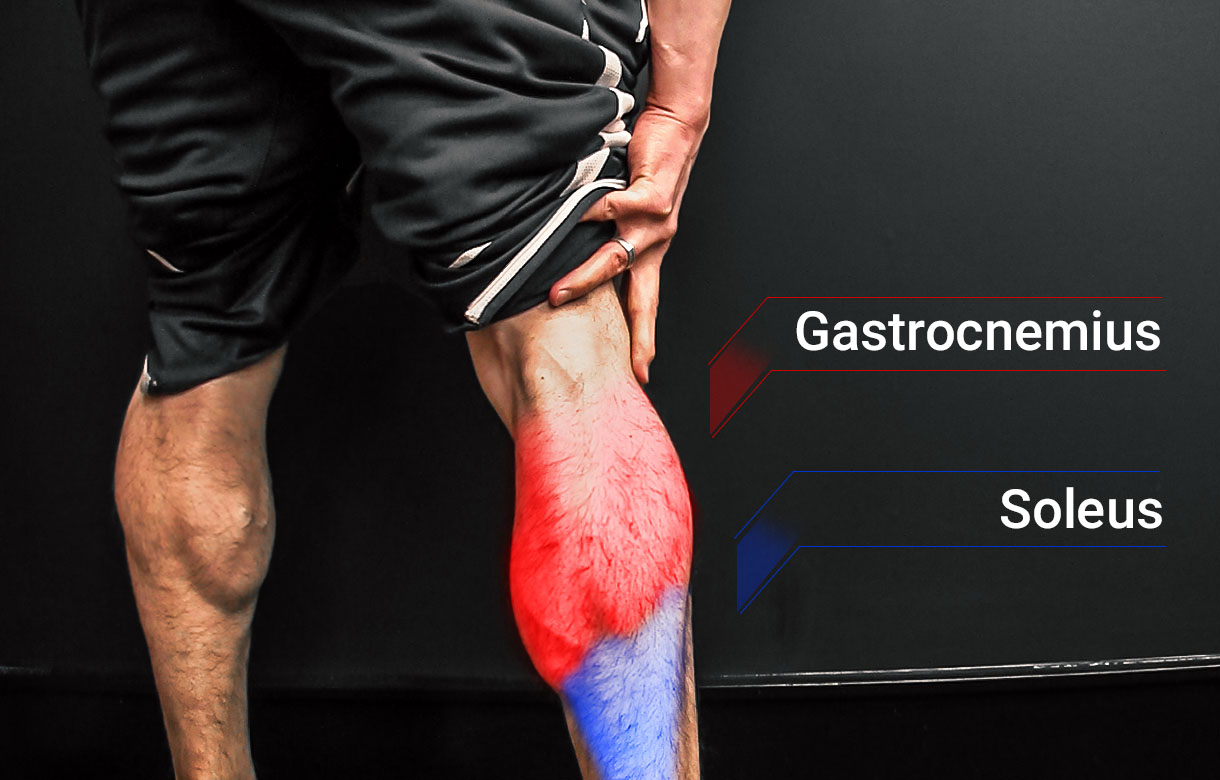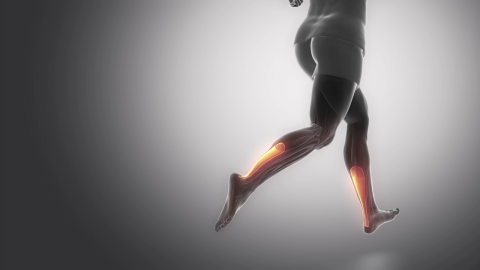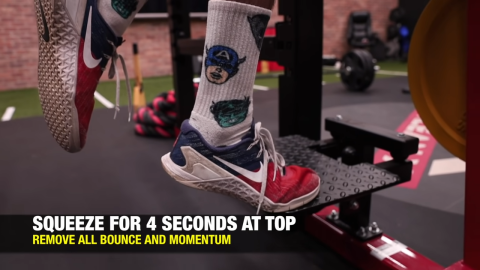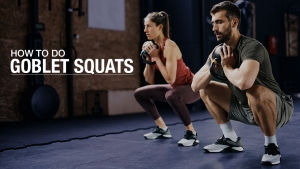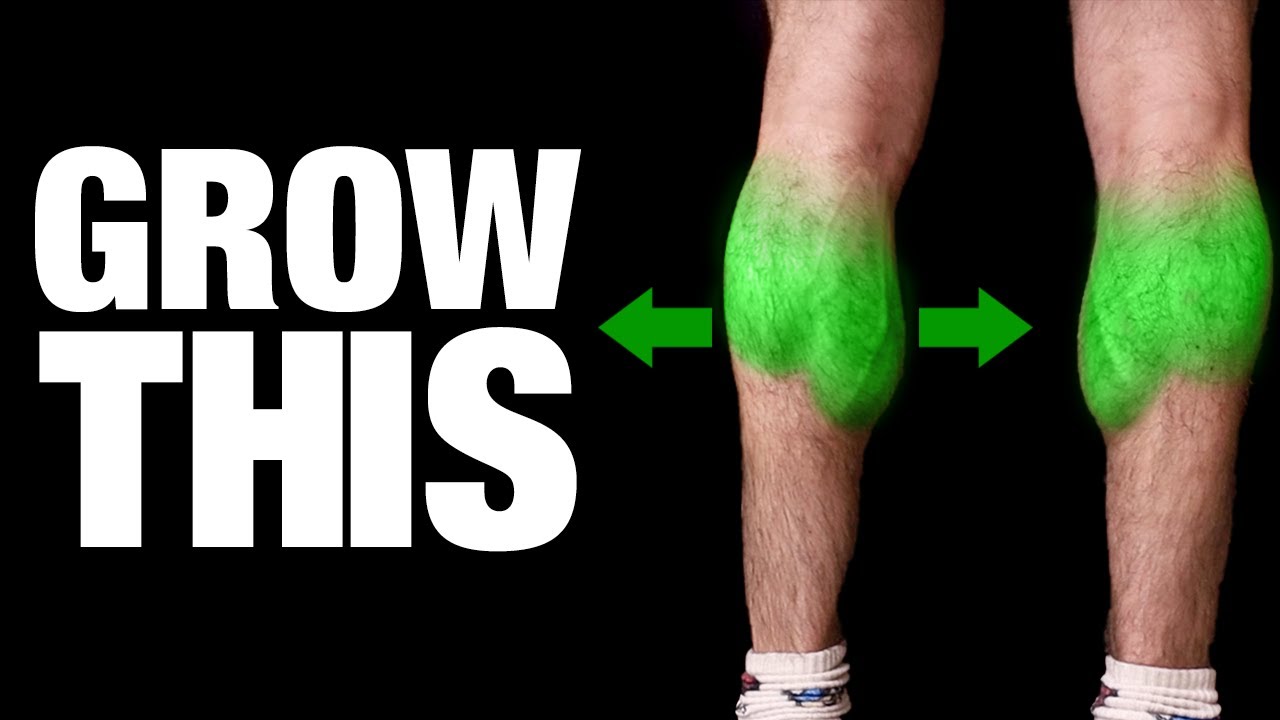
DO THIS FOR BIGGER CALVES
There are the “Haves” and the “Have Nots”, and the “Calves” and “Calf Nots”.
If you’re not one of the lucky people naturally predisposed to muscular calves, you’re a Calf Not.
Calf muscle size is largely determined by our genetics.
The “Calf Nots” with skinny calves have a lower percentage of slow twitch fibers that limit the aesthetic of full beefy calves. Or, they have high insertion points for the calf muscles.
Not everyone can have calves like Arnold Schwarzenegger. But no problem, I have a solution for you.
I’ve demonstrated effective calf exercises in the past, like the Calf Launcher that requires a high-quality bench. There are also a number of calf raise variations you could do, like the seated calf raise, but they often require special equipment.
But, some people don’t have the set up to do these, or they feel it too much in the hamstring because there is hamstring involvement.
As a physical therapist who wasn’t blessed with the genes for big calves, I can tell you that to build bigger calves, you need intensity. One of the best ways to increase the intensity is through volume, using a simple standing calf raise done every single day.
These effective movements won’t take you long, but you have to perform them correctly.
You don’t need any special equipment like a calf raise machine or dedicated donkey calf raise machine. An aerobic step, stair step, or any elevated surface you can stand on will do, as long as it allows your ankle flexion.
Read on to learn how to do the Standing Calf Raise correctly with no equipment required! But first, let’s briefly look at the major calf muscles involved in this exercise.
CALF MUSCLES ANATOMY
There are two primary muscles found in the calves: the gastrocnemius muscle and the soleus muscle.
Building strength in the calves is beneficial because it helps prevent the calf from injury in your training and other athletic activities and improve your athletic performance. If you’re a calf-not, aesthetically you probably want a larger calf muscle to balance out the look of your legs.
- GASTROCNEMIUS MUSCLE: The gastrocnemius muscle is what people think of when they speak of the calf muscles. This muscle assists in knee flexion but it’s primarily responsible for pushing off the ground during athletic movements like when we run, jump, or walk.
- SOLEUS MUSCLE: The soleus is positioned below the gastrocnemius. It’s most active when the knee is bent, and it’s most essential role is plantar flexion (flexing the foot downward during endurance movements like walking and running). It also has a role in foot stability when we are standing. Growing a larger soleus can really help increase the visual size of your calves. Because of its position beneath the gastrocnemius, it can push that muscle outward making the calves look bigger.
We can hit both of these muscles with calf raises so let’s move on to the ins and outs of how to do this exercise and get great-looking calves.
THREE-STEP PROCESS TO GET BIGGER CALVES
If you fall into the ‘calf-not’ category, there’s a three-step process you can follow to overcome your genetics.
Follow these guidelines and extra form tips to start growing your calves.
1) EVALUATE YOUR CALF RAISES
When it comes to direct calf training, calf raises are usually the most effective exercise that the majority of lifters choose. But, it’s important you need to critically evaluate how you’re performing these lower body exercises in order to get the best calf activation.
Doing the standard high repetition, light weights, bouncy approach does nothing more than transfer the load to your Achilles tendon and away from your calves. You’re essentially robbing your calves of any benefit. Rapid-fire calf raises are one of the most common mistakes people make in calf training, and it only causes prevention of calf muscle activation.

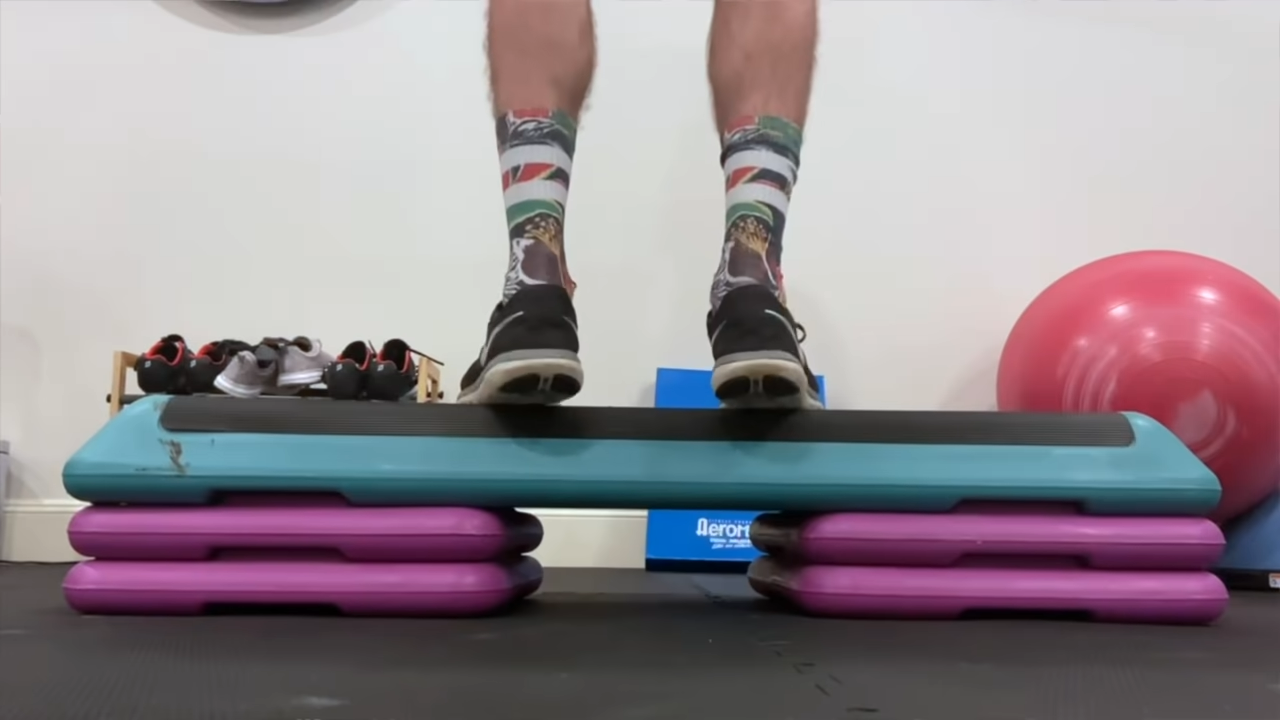
But it also robs the calf muscle itself of a lot of the tension that can be used to grow calf muscles.
So, rapid-fire, bouncing calf raises are inefficient calf builders because the Achilles does its job and takes the load off the target muscle that you actually want to receive that load. Fast calf raises typically lack full range of motion also.
What’s the trick to loading the calves instead of the Achilles, and getting better calf activation?
2) DO SINGLE-LEG CALF RAISES
One of the most effective calf isolation exercises is the Single-Leg Calf Raise. Doing single-leg calf raises delivers more tension into each calf than a barbell calf raise variation or dumbbell calf raise variation performed as a double-leg calf raise. It also has numerous benefits including challenging ankle stability and aids with balance. A two-leg normal calf raise hides imbalances in muscular strength, hinder complete calf development and the bouncing increases risk of injury.
Single-leg calf raises are standing calf raise variations.

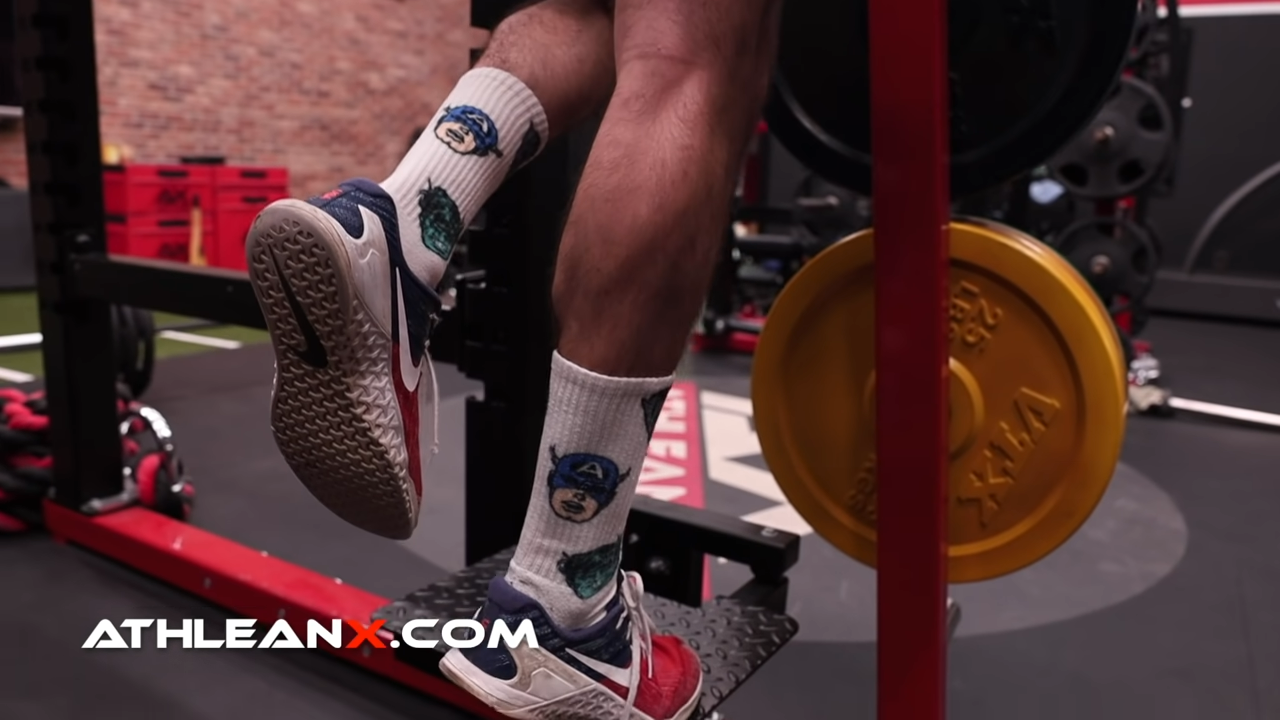
No bouncing motion… make the calf do more of the work. Move slowly between dorsiflexion, up to the top into plantarflexion.
You’ll feel it after only a couple of reps, and it really doesn’t matter how many reps you get.
Do three sets for each leg. Once you can do 10 reps per side, add heavier weights to increase the difficulty of calf raises. Progressive overload always applies.
Three sets is all you need. You can do body weight variations in a free-standing calf raise until you need additional weight.
You can even do a bodyweight calf raise varition at home on a stair step or any elevated flat surface without special equipment. Wherever you choose to do single-leg calf raises, assure ankle stability and hold onto a stable object like a chair for balance.
Don’t count reps for this exercise. A good rule of thumb is to make the reps count instead. Do high-quality reps by going all the way to the bottom and slowing down the cadence, removing the distribution of force that usually gets robbed by the Achilles tendon.
HOW TO DO STANDING CALF RAISES:
- Holding a dumbbell or a weight plate, stand on one leg on a calf raise platform or an exercise step, foot position with the ball of the left foot flat on the surface. Knee position should be directly over the ankles.
- Lower until the calf is in its deepest stretched position at the bottom of its entire range of motion. Your ankle should be more or less directly over your heel.
- After four seconds of stretch in the bottom position, press up in one fluid motion as the calf muscles contract, all the way to the peak of the movement in an extended range of motion.
- Hold that for four seconds, then slowly lower through the eccentric portion, all the way to the bottom for four seconds.
- Maintain proper form, good balance and stable ankles throughout the movement.
- Perform an 8-12 rep range and switch to the other side.
The bonus is that by building bigger calves, you’ll build strong calf muscles too. Stronger calves help offload some of the forces that lead to tears in the Achilles tendon. A well-performed calf raise exercise can also improve ankle mobility.
Perform calf raises daily to get maximum benefits out of this powerful exercise.
Don’t have an exercise plan to follow or maybe you’re looking to change up your current one? We can help!
Program Selector ==> See which program best fits your goals
AX1 ==> Train at Home With Dumbbells and Minimal Equipment
XERO ==> Train at Home With No Equipment

- Calf size and shape are set genetically. Some lifters have muscular calves and some are “Calf Nots”.
- A common mistake when training calves is to speed through the movement, bouncing up and down.
- Bouncing up and down transfers the work to the Achilles tendon and unloads the calves. Using a slow controlled speed works best for calf muscle strengthening.
- Do single-leg calf raises as a bodyweight exercise or use a dumbbell if you need to add extra weight.
- Starting position is on a step with a deep stretch, raise up to plantarflexion and hold for four seconds, then squeeze at the top.
- Descend to the bottom and hold again for four seconds. Concentrate on getting a full range of motion.
- Do three sets for each leg, and don’t worry about the number of reps. Make the reps count instead of counting the reps. Do these as a daily movement.
- When you can do 10 reps, increase to a more moderate weight.
STANDING CALF RAISES FAQS
Calf raise exercises are simple to perform. Avoid the calf exercise machine and instead perform a bodyweight single-leg standing calf raise or add dumbbells or lighter weight plates to it.
Begin in the starting position by standing on a step or other elevated surface. Standing on the ball of the foot, let the ankle and heel sag downward until you feel the back of your lower leg stretch, as far as the calf's range of motion allows. Then slowly and using controlled motion throughout the range, press all the way up.
Add a pause at the bottom and top of the range of motion to increase the time under tension will increase the muscle-building effect. It's important to perform these as slower movements to get the best calf activation.
You can also perform this fantastic movement on stairs or any other elevated srface at home.
The calf raise is an important part of a complete lower body workout, however, you can do calf raises daily if you want to see fast results.
How many calf raises you do isn’t nearly as important as how you perform your calf raise training. Avoid the machine calf raise and do single-leg calf raises instead. Do them slowly on each leg until fatigued. Do three sets of these daily. Once 10 repetitions can be performed, add weight to increase the intensity.
Calf raises have been a standard weight training exercise for many lifters. They’re usually performed on a step or other elevated surface by standing on the balls of the feet and pressing upward. Seated calf raises are less effective because you don’t have the benefit of bodyweight, gravity and the entire leg working in concert. Avoid the calf raise machine and opt for standing single-leg calf raises.
No. Calf raises will not make you taller.
Calf raises cause the calf muscles to flex under tension, which encourages the muscles to grow in response. Done properly, they can add shape and size to the lower leg between the ankle and the knee.
Yes. Calf raises work to build the calf muscles, even in the presence of genetically smaller calf muscles. They must be performed correctly, slowly and without bouncing.
REFERENCES

Jeff Cavaliere M.S.P.T, CSCS
Jeff Cavaliere is a Physical Therapist, Strength Coach and creator of the ATHLEAN-X Training Programs and ATHLEAN-Rx Supplements. He has a Masters in Physical Therapy (MSPT) and has worked as Head Physical Therapist for the New York Mets, as well as training many elite professional athletes in Major League Baseball, NFL, MMA and professional wrestling. His programs produce “next level” achievements in muscle size, strength and performance for professional athletes and anyone looking to build a muscular athletic physique.
















